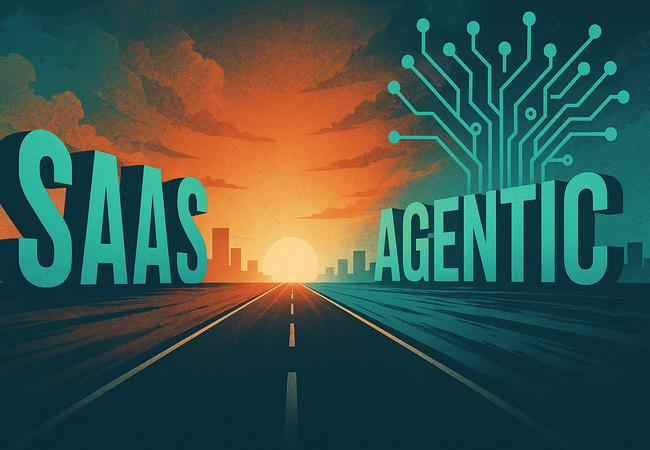
The SaaS Era Is Ending - Software’s Next Phase Is Outcome-Centric and Agentic
The Signal Is Clear
Microsoft CEO Satya Nadella recently said, "Every product will have a copilot." [1] But this isn’t about adding AI chatbots to software - it’s about shifting the very foundation of how software delivers value. The future isn’t SaaS. It’s agentic.
What’s Changing — and Why
- Marc Andreessen wrote in 2024 that "the interface is becoming intelligent by default." [2]
- Benedict Evans noted that "apps will become workflows. Tools become collaborators." [3]
- Gartner predicts that by 2026, over 70% of enterprise apps will include generative agents guiding user interaction. [4]
The core shift? From tools that execute commands to systems that understand outcomes.
What Is “Agentic”?
Agentic systems don’t just wait for input; they act with context.
They observe, guide, follow up, and adjust.
They help users complete real goals, not just click through UI.
Instead of:
Click Settings → Billing → Subscription
You get:
“Looks like you're trying to manage your plan — would you like help with that?”
Agentic systems:
- Adapt to intent in real time
- Remember context across sessions
- Make software feel like a helpful teammate
- Work across app boundaries - outcome over architecture
The Evidence Is Already Here
- Microsoft Copilot is integrated across Office, GitHub, Windows, and now Teams, not as chat, but as workflow augmentation
- Notion AI and Grammarly GO use context to proactively suggest next steps
- Salesforce Einstein 1 is shifting from dashboards to outcome orchestration
- Figma’s AI now extends ideas, not just draws boxes
- Startups like Adept, Rewind, and Glean focus entirely on agentic flows
What It Means for Builders
This isn’t just an AI moment — it’s a product strategy pivot:
Old model:
- Build static flows
- Hope users understand
- Optimize for clicks
New model:
- Model outcomes
- Inject smart guidance
- Measure time-to-success
How to Respond
- Audit high-friction user moments - these are prime for agentic intervention
- Frame outcomes, not features
- Design with intelligence hooks - track state, context, and user progress
- Pilot agentic patterns like Ask + Confirm, Handoff + Resume, Track + Remind
- Shift your roadmap lens from capabilities to outcomes
Note to Skeptics
This isn’t about hype. It’s about adapting product thinking to match how users now expect software to behave. Agentic design doesn’t demand that you abandon existing UX; it lets you enhance it in practical, intelligent ways that drive measurable value.
Final Thought: A Better Software Contract
Agentic software is a new kind of promise. Is not “we’ll give you features” - Is “we’ll help you succeed.”
As Nadella said:
“The dream is to have agents that understand your goals and take action — across apps, systems, and workflows.” [1]
That dream is becoming the new standard.
References
[1] Microsoft Ignite 2023 Book of News — https://news.microsoft.com/ignite-2023-book-of-news/ - https://news.microsoft.com/ignite-2023/
[2] Marc Andreessen, "The Interface Is Now the Agent" — https://a16z.com/ai-copilot-ai-agent-white-collar-roles/
[3] Benedict Evans, "AI and the Next UX" — https://www.ben-evans.com/benedictevans/2023/11/5/ai-and-the-next-ux - https://www.ben-evans.com/benedictevans/2023/10/5/unbundling-ai
[4] Gartner, Strategic Technology Trends 2024 — https://www.gartner.com/en/newsroom/press-releases/2023-10-16-gartner-identifies-the-top-strategic-technology-trends-for-2024
[5] Product Examples: Notion, Grammarly, Salesforce, Figma, Adept, Rewind, Glean